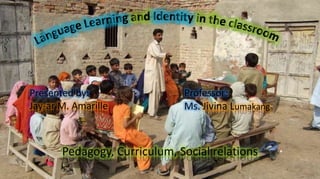
Pedagogy, Curriculum and Social Relations Analysis
- 1. Pedagogy, Curriculum, Social relations Presented by: Jay-ar M. Amarille Professor: Ms. Jivina Lumakang
- 2. •Identity develops in day-to-day experiences that occur through participation in communities of practice (Wenger, 1998). •This identity development, according to Pavlenko and Blackledge (2004), can be imposed and thus not negotiable, assumed and accepted but still not negotiated, or negotiable and thus changed by the (L2) second language learner. Further, as Block (2007a: 864) notes, a poststructuralist approach to identity ‘has become the approach of choice among those who seek to explore links between identity and (L2) second language learning’.
- 3. Poststructuralist theories of language emphasized the study of the linguistic knowledge (competence) that allowed idealized speakers/hearers to use and understand language’s stable patterns and structures (Saussure, 1966). Russian literary theorist Mikhail Bakhtin (1981, 1984, 1986) saw language not as a set of idealized forms independent of their speakers or their speaking, but rather as situated utterances in which speakers, in dialogue with others, struggle to create meanings.
- 4. Pedagogy - approach to teaching, refers to the theory and practice of learning, and how this process influences, and is influenced by, the social, political and psychological development of learners. •Academic Discipline •Study of how knowledge and skills are imparted in an educational context. •Considers the interactions that take place during learning. Both the theory and practice of pedagogy vary greatly, as they reflect different social, political, and cultural contexts.
- 5. Pedagogy is a sustained process whereby somebody(s) acquires new forms or develops existing forms of conduct, knowledge, practice and criteria from somebody(s) or something deemed to be an appropriate provider and evaluator’ (Bernstein, 2000, p.78). Two models of pedagogy 1. Performance model: visible pedagogies where the teacher explicitly spells out to the students what and how they are to learn, with a recognizable strong framing or lesson structure, collective ways of behaving and standardized outcomes; 2. Competence model: invisible pedagogies with weaker framing that result in an ostensibly more informal approach where the teacher responds to individual children’s needs, with hidden or unfocused learning outcomes.
- 6. Alexander’s definition of pedagogy - comprises teachers’ ideas, beliefs, attitudes, knowledge and understanding about the curriculum, the teaching and learning process and their students, and which impact on their ‘teaching practices (2001, p.540) Pedagogic approaches Pedagogic strategies Teaching practices As with the term ‘pedagogy’, the term ‘effective’ is contested. The ultimate goal of any pedagogy is to develop student learning.
- 7. Theories of learning Behaviourism Thorndike (1911), Pavlov (1927) and Skinner (1957) proved laws of stimulus-response and classical and operant conditioning were used to explain the learning process through the use of rewards and sanctions – or trial and error. Constructivism Piaget (1896-1980) Child-centred education – individual learners actively explore their environment by building on their existing cognitive structures or schemas. Social constructivism (Vygotsky 1986) Zone of Proximal Development – sees knowledge as socially constructed and learning as essentially a social process; cultural tools, above all by language, which needs to be the learner’s first language.
- 8. Broad theoretical school of thought Associated pedagogy Examples of pedagogies in developed countries Examples of pedagogies in developing countries Behaviourism Teacher–centred learning ‘Performance’, visible pedagogy Whole class teaching, working together as a collective (Japan, the Pacific Rim) Focus on mastery of skills in a particular sequence Lecturing, demonstration, direct/explicit instruction, rote learning, choral repetition, imitation/copying, ‘masterclasses’ (e.g. learning music or dance) Constructivism Child-centred learning ‘Competence’ or invisible pedagogy Project work; individual activity, experiential, Montessori; Steiner; Pestalozzi in US and Europe Activity-Based Learning in Tamil Nadu Bodh Shiksa Samiti schools in India Social constructivism Teacher–guided Learner /student–centred learning Reciprocal teaching of reading in US Communicative learning Co-operative learning Group work element in national strategies, England Small-group, pair and wholeclass interactive work, extended dialogue with individuals, higher order questioning, teacher modelling, showing, problem solving, inquiry-based, Nali Kali in India, thematic curriculum in Uganda
- 9. Curriculum The curriculum is the key reference point for teachers, particularly in developing countries, where it is encoded in the official textbook and teacher guides, often the sole resource used by teachers. Teachers’ pedagogic approaches, strategies and practices thus serve to enact the curriculum. The curriculum links the macro (officially selected educational goals and content) with the micro (the act of teaching and assessment in the classroom/school), and is best seen as ‘a series of translations, transpositions and transformations’ (Alexander, 2009, p.16; original emphasis).
- 10. Four (4) models of the curriculum 1. Content-driven curricula – mathematics or science are used to describe the curriculum, with increasing specialization for older students (Bernstein, 1975). 2. Process-driven curricula – content areas stand in an open relation to each other. Students have more discretion over what is learnt compared to individual teachers, who have to collaborate with colleagues from other disciplines (Ross, 2000). 3. Objectives-driven curricula – structured around sets of expected learning outcomes, which are written by specifying the kind of behaviour as well as the context in which that behaviour is expected to operate, e.g. comprehending, applying, analysing, starting with lower-order objectives and moving to increasing levels of complexity (Tyler, 1949). 4. Competence or outcomes-based curricula – are structured around sets of learning outcomes that all learners are expected to be able to achieve successfully at the end of their learning experiences (Botha, 2002).
- 11. Social relations •The curriculum reflects officially and ideologically selected knowledge (Apple, 1982), but is also a vehicle for change — what the society wants to be in the future. Thus, ‘curriculum change often goes hand in hand with and reflects social change’ (Paechter, 2000, p.5). •By deciding to educate children differently, social transformation might be realized (Young, 1971).